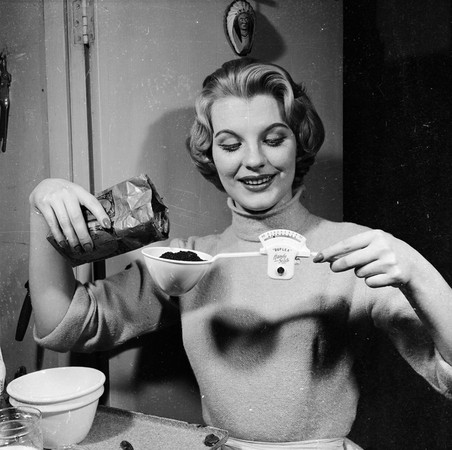You’re probably wearing clothes as you read this. They’re not likely to be terribly stained and probably don’t smell like fermented sweat. And odds are, it will take you less than an hour this week to make sure your clothes look and smell somewhat acceptable.
That wasn’t always the case. This is what housewives had to put up with until well into the 1930s:
- Fill washtub with buckets upon buckets of water;
- Heat the washtub on the stove or over the fire;
- Treat each stain with a different formula;
- Put the laundry into the washtub;
- Manually stir and scrub the laundry for hours;
- Drain and refill with fresh water;
- Treat the laundry with starch;
- Wring out the laundry by hand or put it through the wringer;
- Hang the laundry out to dry;
- Heat up the iron with coals; and
- Iron everything – a day’s work in itself.
The washing machine changed everything. “Suddenly the big ‘Wash on Monday’ could be done in little loads throughout the week,” says laundry historian Carianne van Dorst.
Household appliances such as the washing machine truly revolutionized daily life. “In 1900 the average [American] household spent 58 hours a week on housework – meal preparation, laundry and cleaning,” writes economic historian Jeremy Greenwood. “This compares with just 18 in 1975.” So there’s good reason for Greenwood to call these appliances “engines of liberation.”
And yet somehow a Kenmore Elite 4107 is less likely to make us think of innovation than an iPhone 6S Plus.
The cliché of our time
They can be found at every convention: trendwatchers preaching the wonders of innovation. Organizations, the education sector, public administration – everyone has to adapt to the disruptive impact of technology.
Robert J. Gordon lays that cliché to rest in his new book
There you have it, the persistent conviction that the world is changing faster than ever. And that we are going to have to adapt faster than ever to keep up.
Robert J. Gordon lays that cliché to rest in his new book The Rise and Fall of American Growth. He argues that ours is a time not of technological revolution, but of technological stagnation. However, there was a deluge of Great Inventions between 1870 and 1970 – Great Inventions that solved problems which we have long since forgotten ever existed.
What Great Inventions?
In 1898 delegates from the world’s largest cities met in New York City for the first urban planning conference. The most important item on the agenda was not housing, land use, economic development, or infrastructure. On the contrary, writes historian Eric Morris, “the delegates were driven to desperation by horse manure.”

A dishwasher. Photo by Getty
Yep, horse manure was the urban dilemma of the time. In 1894 The Times of London predicted that by 1950 every street in London would be filled with nine feet of horse manure.
We’re no longer aware of it, but in the 19th century the most important urban modes of transport were the omnibus, the horse-drawn streetcar, or quite simply the horse. And horses – unlike today’s streetcars, busses, and cars – had the irritating habit of leaving their copious droppings all over the roads.
You can imagine the consequences. On hot days the horse manure dried up into flakes that blew into the faces of innocent bystanders. On rainy days the dung transformed into a slick mass of slurry, covering the roads with slippery sludge. Horses regularly lost their footing in the mire. A fallen horse caused huge delays – getting a creature weighing nearly 1,500 lb. back up and moving was no small feat.

An inflatable laundry basket apron. Photo by Getty
When horses fell and became hopelessly injured, they were usually left behind. A dead horse was not easy to move. So people often waited until the horse started to rot and soften. That resulted in a somewhat macabre street scene, but it made it a lot easier to chop and saw the carcass into pieces and eventually drag it away.
Motor vehicles and electric streetcars caused the horse to largely vanish from city streets. My generation hasn’t experienced a comparable revolution in city transport. Aside from the odd Segway enthusiast, we still travel by bike, train, streetcar, bus, subway, and automobile.
And our transport doesn’t move much faster than in the past, either. Sure, the speed limits on our freeways have gone up some in recent years. And high-speed rail systems have popped up here and there. But by and large, we still travel around town just as we did 10, 20, 30 years ago.
So what about our Great Inventions?
Are there no more Great Inventions? What about the computer, the smartphone, and the internet? Sure, punch cards have been replaced by spreadsheets, typewriters by word processors, pagers by smartphones, and family albums by Facebook. The disruptive power of the internet continues to cause bookstores, video rental places, and clothing shops to fall like dominoes.
Our Great Inventions have had an impact. But we shouldn’t exaggerate the scope of the change they’ve brought about
Indeed, no one can deny that our Great Inventions have had considerable impact. But we shouldn’t exaggerate the scope of the change they’ve brought about. How we transport ourselves, what we eat, how we cure diseases, what clothing we wear – the internet has barely changed these things.
The difference is that between 1870 and 1970 there was not only an information revolution, but also revolutions in transport, sanitation, household appliances, entertainment, food, and clothing. Nearly every aspect of daily life changed.
The upshot: we could continue to live
Technology literally gave us time to live.
It’s a shocking statistic: one third of all US children born in 1860 didn’t make it to their fifth birthday. That’s right, one in three. Two generations later, that number had declined dramatically. By 1960, one child out of 30 died before reaching kindergarten age, and now just one in 200.
Not surprisingly, enormous changes took place in the interval. Open sewers full of human excrement and swarming insects were replaced by sanitary sewage systems. Dentists anesthetized their patients with an injection of lidocaine instead of a shot of liquor. Vaccinations helped to eradicate diseases that for many people today are nothing but a vague memory, such as polio and smallpox.
The changes in the medical world in the past 50 years have been far less revolutionary. In 2007 The British Medical Journal held a survey among its readers asking them which inventions had led to the greatest medical advances. The “sanitary revolution” scored highest, followed by antibiotics, painkillers, and vaccinations. These are all inventions from the second half of the 19th and first half of the 20th centuries. The highest ranking invention from the second half of the 20th century, DNA, only came in fifth.
Today’s improvements mainly concern quality of life: prostheses, mental health care, and medication with fewer side effects. These are improvements, but not revolutionary ones.
Why do changes today seem so radical?
If it’s really true that we’ve experienced much less change than previous generations, and that our era is one of many improvements but few revolutions, then why do we perceive ourselves and the times so differently?
I think there are two reasons for this. Changes that we experience ourselves simply resonate with us more. Anyone who has heard the shrill tones of a fax machine knows how much more pleasant email is.
No one wastes a moment anymore contemplating the inconvenience of intercontinental mail correspondence. But in 1815, things were different. The British and the Americans were still engaged in battle near New Orleans. As battles go, that one has to go down as one of the more pointless ones, because two weeks earlier a peace treaty had been signed in Ghent. But the message had never reached New Orleans.
The smallpox vaccine, the bus, and the vacuum cleaner – we simply take them for granted
The first intercontinental telegram was only sent 30 years later, and it reduced delivery time from several weeks to several minutes. In terms of pure speed, the step from mail by ship to telegram was undoubtedly greater than the step from fax to email.
A second reason for our distorted self-image is that the technology of the past mainly created time, whereas today’s technology fills it.
This morning I watched a rock climber scale a boulder on YouTube; I read an article on Wikipedia about what an awful guy Vlad the Impaler was; and I worked on an article for The Correspondent.
The fact that I’m not lying in bed full of festering red lesions or didn’t stumble over a dead horse on the way to work and don’t have to worry about clouds of dust in my bedroom – these things are so self-evident that I rarely even stop to think about them. The smallpox vaccine, the bus, and the vacuum cleaner – we simply take them for granted.
How important are they? They determine the very way we live our lives.
What does the future hold?

A headset. Photo by Getty
Gordon goes yet one step further in his book: he argues that the slower pace of technological change is probably permanent. It’s difficult, he reasons, to imagine where huge improvements are going to come from, because the low-hanging fruit of technology has already been picked.
He’s got a point. It’s not likely we’ll reduce child mortality by a factor of a thousand again soon, nor can we eradicate infectious diseases a second time. We have it so good in some areas that only marginal improvements are possible.
On the other hand, it’s always difficult for us to imagine scientific breakthroughs before they happen. They are inherently unpredictable.
Maybe 3D printers will cause industry to shift its focus to delivering raw materials and designs in the future. Maybe we’ll find a cure for cancer. Maybe one day artificial intelligence will pen an article far superior to our human-authored ones about the benefits of technology.

A spoon scale. Photo by Getty
What Gordon has managed to do in any case is provide a counterargument to today’s pro-technology rhetoric. Corporate moguls and politicians attending the World Economic Forum in Davos were already busy discussing the “fourth industrial revolution.” That seems rather premature.
Improvements occur gradually in most facets of life. Cars become more energy efficient, televisions broadcast in color, and light bulbs last longer. But there are no longer clear breaks with the past.
And yes, I am now able to buy a cat feeder that allows me to put my cat on a fully automated diet (with a scale, camera, and cat facial recognition software).
But it’s not cat recognition software we see in our dreams of the future.
We want flying cars!
— English translation by Mark Speer and Erica Moore






